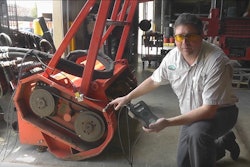
There are plenty of obvious reasons to convert your maintenance and equipment inspection processes from paper records to digital: improved safety, shop efficiency, regulatory compliance and reduced downtime.
What’s more, electronic records can be easily upgraded and customized into different fields. You can track hours per service or repair. Inspections can be shared with your people, vendors and dealers. Repair histories can be called up instantly by anyone without having to thumb through hundreds of paper files. Inventory can be tied to the reports so you’re not caught emptyhanded on oil filters or other supplies.
Sharing is good
But the most important reason to move to paperless equipment inspections may not be so obvious, yet it has the potential to significantly transform your operations and your relationships with vendors, customers and other divisions in the company.
That benefit is the sharing of data, says J.P. Giometti, director of strategy and business development at the software company HCSS. “If you’re smart about how you share the data, you can create beautiful workflows in your company,” he says.
Giometti, who shared his insights at the Association of Equipment Management Professionals 2017 EquipmentShift conference recently, says paper records have advantages and disadvantages, but their biggest weakness is you can’t share them.
“When information can flow through your organization, you and your partners and vendors can do something with it,” Giometti says. And if you can automate some of the work you do, you can focus on what matters and not the tedious chore of processing paper, he added.
Ben Tucker, director of equipment and facilities at Barriere Construction headquartered in Metairie, Louisiana, manages a fleet of about 250 on- and off-road assets with a staff of equipment coordinators. Despite the company’s fleet size, it outsources all its maintenance and repair work. Tucker views his B2W Software digital inspection reports as essential to communicating with these outside vendors. The efficiency and timeliness of the reports enable these service providers to maximize their time in the field, he says.
Destroying downtime
Tucker started using paperless inspections and equipment management about a year and a half ago. Since then he has been able to cut the company’s percentage of machines undergoing emergency repairs almost in half. “For years, we couldn’t get our emergency repair rates below 5 percent,” he says. “Now we’re tracking at below 3 percent, and this year, we’ll probably finish up around 2 percent.”
One of the most significant contributors to this improvement in uptime is the speed with which a paperless system records information. In the past, if an operator or technician reported a problem on the old paper-based system, it could take up to a week before the form reached a vendor or somebody who could get something done.
“The paperless system streamlines the process of getting the information from the field to the vendors to get the work done,” Tucker says. “It gets you on a more proactive timeline on certain things that are critical to the operation. It’s coming in real time.”
Accurate data
The accuracy of maintenance data is also a key issue for fleet managers, says Derek Piwonka, division fleet manager for rail at Balfour Beatty in Colorado. As an example, if an hour meter is broken on a machine or a technician writes down the wrong hours or the wrong machine identification number on a paper form, those errors would get filed away in a paper system, possibly resulting in a missed oil change or service interval, Piwonka says. With a digital system tied to the machine’s telematics and GPS, such mistakes are easy to spot or immediately obvious. Alerts, notices of pending PMs or warnings can be sent automatically via email to everyone who needs to know.
Piwonka started employing digital maintenance recordkeeping in preparation for the electronic logging device mandate for trucks about two years ago and is rolling out a similar initiative to put all his yellow iron assets online using a Telogis Fleet and Compliance system. Before the company started digitizing the information and putting it on the cloud, he was faced with what he calls a “blizzard of paperwork.” Along with the company’s IT staff he’s also structuring his Telogis data to feed into the company’s enterprise resource program (ERP) to better share and inform people outside of the maintenance arena.
With his yellow iron coming on line, Piwonka intends to perform detailed oil change-interval studies on his equipment. Accurately recording the hours of a large number of machines will improve the quality of the study and greatly reduce the paper computations that doing such research by hand would require, he says.
Visual evidence
In addition to pushing data around the internet, many digital maintenance and inspection systems allow the technician to take a photo of a problem or repair and upload it to the file or a repair or maintenance log. Having the ability to take photos helps a lot, says Tucker, especially when you are using outside vendors for service.
A more advanced option for visuals comes via augmented reality by using screens or goggles such as HoloLens. “The more sophisticated companies are using augmented reality technology,” says Giometti. “It’s at an early stage, but being able to see a machine’s status simply by glancing at it through an augmented reality display could be incredibly powerful. I suggest you at least learn what is there so you can have a conversation with your vendors.”
An intermediate step to autonomy is using a service like Facetime where a technician connects with an expert back in the office and shares real-time video images of a component or problem. The expert looks at what the technician sees and guides the technician. This allows fleet managers to send less experienced technicians into the field, knowing they have a real-time backup for instructions and advice.
Systems and devices
When evaluating a maintenance software package, one of the first decisions you’ll have to make is about the hardware – the tablet or device on which the information is recorded, says Giometti. The options include:
• A device for each piece of equipment. This is a good fit for small fleets, but gets expensive for bigger ones. Misplacement of the device is unlikely since it stays with the machine.
• A device for each employee. The device can be an employee’s personal phone or a tablet issued by the company. Using personal phones is easy, but companies are required to reimburse employees for a percentage of their monthly bills. Still it can be less expensive than buying a dedicated device for every technician or mechanic. Company-issued tablets can be expensive and require some tracking as an asset.
• One device for everybody to share. This may be the least expensive option, but depending on just one device for multiple employees and equipment can be problematic. Giometti says he rarely sees companies adopt this option.
The big challenge
As with any major systems change, the biggest challenge is often selling the idea to the executive suite and the employees under your supervision. Giometti lists four suggestions for making this happen:
1. Make sure you know what is available on the market. Survey all electronic inspection options to find the best fit. Ask questions and understand the potential ROI for your business.
2. Have a plan to get internal champions and early adopters on board. You don’t have to know everything. You know equipment, you know your business. Get some millennials to help you in the transition. Own it and then put a team around you. This is not about technology; it’s about mindset.
3. The champions who work with you on the pilot should encourage employees to buy into the technology by sharing its benefits.
4. Reward top performers. Gamification techniques offer a lot of room for creativity in coming up with reward programs. The more data you collect in your system the more ideas you can think up to help employees achieve companywide goals. Examples include rewarding people for the number or percentage of inspections completed. You can also use the data to establish performance bonuses.
Small fleet solutions
If there is a negative to implementing a paperless shop management system, it is the cost and the initial ROI. Software isn’t free, and training and adoption can take time and resources.
But the situation is not as daunting as it may seem, especially for contractors with small fleets. At its simplest, you can start recording all your inspections, processes and timelines on an Excel spreadsheet or Google Docs, says Giometti. These don’t have the interoperability of most sophisticated programs. You cannot mine the data for insights or export the data into an ERP program, but they are easy to share.









